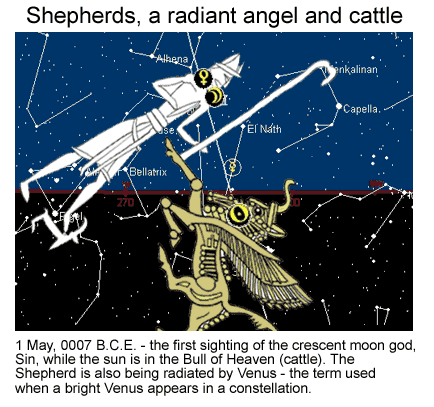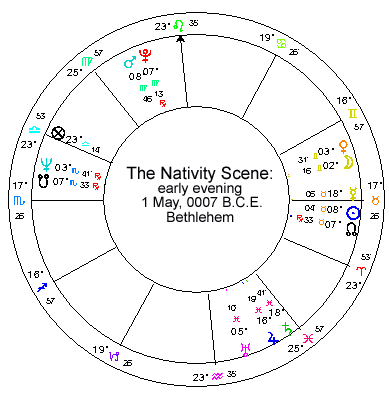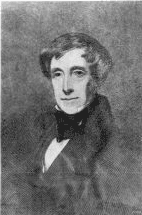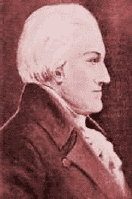|
A joint publication of: Astro Logos and Zyntara Publications |
||||||||
|
ISSUE NO. 12 |
||||||||
|
|
||||||||
|
December 2005 |
||||||||
|
The VAN
is a free monthly electronic newsletter |
||||||||
|
In this issue: |
To
subscribe or |
|||||||
| The Star of Bethlehem, shepherds, a manger and those kings…- Bernadette Brady | ||||||||
| A Chorus From Christmas Past - Darrelyn Gunzburg | ||||||||
|
VAN Archive - www.Zyntara.com |
||||||||
|
Introduction Right symbolism but wrong latitude - In the November issue we looked at the possible location of the Neptune, Saturn, Mars T-Square. There were quite a few events which this could have embodied but the major event which captured the symbolism of the T-square was, I believe, the chemical factory explosion at 1:45 p.m. on 13th November, 2005, in Jilin, China (43N51 and 126E33).The Songhua River, a major water supply for the area, became heavily polluted as a result but it was was only after the pollution started to enter Russia that the Chinese admitted the problem. The chemical plant had a record of pollution but had done little to clean up its act over the years. Now all the symbolism of the T-Square is contained in this event but I did not come anywhere near the correct latitude. So this needs to be unpacked and studied further. Such failures can often teach us more in retrospect than a success.
In the meantime this is our Christmas issue of the VAN,
and both Darrelyn and myself and the rest of the team at Astro Logos and
Starlight would like to take this opportunity to wish you all a very
fruitful and joyful solstice season. |
||||||||
|
The Star of
Bethlehem,
shepherds, a manger and those kings… There are not too many sky narratives left in our culture. We have children’s songs and rhymes about twinkling stars or new moons, we have the sadness of lost love in such songs as "Blue Moon" but generally the sky does not rate too much attention in our oral or written traditions. However, there is one sky narrative which is celebrated every year in the western world and this is the story of the Star of Bethlehem and how it is linked to some shepherds, the journey of three kings and a new born king in a manger.
There are many interesting things about the story of the nativity and a most obvious point is that unlike other birth stories of Emperors and Kings who prefer to locate their stories in the glory of the sun (locating their births at high noon or at the moment of dawn), Christ’s birth story has always been set at night. This night setting hints that the story may well be about the starry sky with the players being stars or planets rather than actual people. Or that it could be a story of the horoscope of the new king, a horoscope not drawn on fragile paper but drawn in the far stronger and longer-lasting medium of story.
The story has two different accounts. One is from the Gospel of Luke (Luke 2:1-20) which gives us half the classic nativity scene. Luke’s story is of a group of shepherds who are out in the fields at night. Suddenly a radiant angel appears in their midst and this angel informs them of the birth of the new king. They are told that this new king can be found in a manger. In contrast, the Gospel of Matthew( 2:1-11) makes no mention of mangers or shepherds but focuses solely on the magi and their interaction with King Herod. The different elements of these two distinct gospel stories have merged in the classic nativity scene of manger, child, cattle, Holy Family, three wise men and a group of shepherds.
But let us unpack this story. In looking to the sky, researchers have appeared to disregard the Gospel of St. Luke and focused on St. Matthew’s comments about a bright star. This star is considered to be the Jupiter-Saturn conjunction amongst the stars of Pisces in 0007 B.C.E. which indeed would have appeared as a bright lone star and would have attracted the attention of the Babylonian astrologers. In contrast to this, St. Luke’s story is not thought to contain any significant sky elements and his comments about Christ in a manger have been interpreted as the birth occurring in a humble cow shed with the excuse that the inn was full. St. Luke’s Gospel therefore is interpreted as a story that emphasises Christ’s humble origins, with the shepherds, at best, symbolising Christ’s link with the Lamb of God or, at worst, nothing but “fillers” in the classic nativity scene.
I believe that St. Luke’s Gospel may also be a sky event but one that describes a Babylonian view rather than the potential Hellenistic view of St Matthew.
Shepherds in the Sky
The Babylonians had eighteen constellations. Three in particular are of interest to the nativity scene. The constellation Orion was known to the Babylonians as the True Shepherd of Anu, where Anu was the location of the sky, meaning the ecliptical area. Opposite Orion, on the other side of the ecliptic, was the constellation that we know as Aurgia, the Charioteer. However, to the Babylonians this was known as the Crook, as in the shepherd’s crook. So this part of the sky was a large image of a shepherd and his crook which stretched across the line of the ecliptic (see the image below).
The Babylonians sky watchers who recorded and collected sky records over
many centuries would have considered the forthcoming joining of Jupiter and
Saturn as a key event. Their interpretations of both the role of Saturn as
king and Jupiter as crown prince may have lead them to expect either a
special union of the king with a crown prince or the birth of an
undisputed, legal and accepted crown prince. The Saturn-Jupiter
conjunction occurred three times from May to early December 0007 B.C.E.
and to the Babylonian sky watchers, the whole period of seven months would
have been under the influence of this unfolding sky narrative.
One of the times of key observation would have been
the first sighting of new crescent moon each month, as this was the
birth of the moon god, Sin.
Added to this was another sky omen. Any
constellation which contained a bright Venus as a morning or evening star
received a blessing or radiation from that goddess, particularly if the
constellation the Crook received this radiation. For then, according to
the Assyrian priest, Bullutu, writing around 679 – 665 B.C.E, such a
radiation resulted in the prophecy that “the foundation of the throne will
become stable.” (Hunger 1992:73) With this in mind we can now return to the Gospel of Luke which reported that there was a group of shepherds and that appearing amongst this group was a radiant angel with a message about a newborn king. The shepherds are informed by this messenger that the new born king will be found in a manger. Viewed with an understanding of the Babylonian sky view, we can start to see the possible sky elements in Luke’s Gospel.
Having found a potent time for the birth of a new king, St. Luke's gospel may also describes the location of the new king, the all important location of the sun. We are told that the new king is resting safely in a manger which could refer to the sun being amongst the stars of the Great Bull of Heaven. He (the sun) is with cattle or in a manger (see image above). Here we can now see all of St. Luke's story components - the shepherd, the radiant angel and the new king in the manger.
Thus it is quite possible that the classic nativity scene is actually a horoscope which has been written in the medium of story, a medium which has allowed it to carry its sky message over several millennia. So the next time you sing about shepherds who watch their flocks or three kings bearing gifts or the classic children’s carol Away in a Manger or look at a nativity scene in a shop window, step back and look at the imagery in the story and take joy in the role that visual astrology may well still be playing in our culture.
Sources Ptolemy Claudius (1917) The Tetrabiblos. Translator J.M.Ashmand. London: Foulsham & Co Ltd.
|
||||||||
|
We are walking towards the Solstice, that moment in time when silently the world turns and breathlessly the world waits…
'Twas the night before Christmas, when all thro' the house, Not a creature was stirring, not even a mouse;
This poem, originally titled "A Visit From St Nicholas" but commonly known as "'Twas the Night Before Christmas", was first published anonymously in the Troy Sentinel, New York, on 23rd December, 1823. It was an immediate success. Twenty years later, amidst high popularity, Clement C. Moore asserted authorship of the work. However, recent scholarship by literary critic Don Foster (1) has cast doubt on this attribution and accorded the poem instead to Henry Livingston, Jr. a position constantly asserted by Livingston’s family.
In this
winter solstice edition of the Visual Astrology Newsletter, I thought it
might be enjoyable to see if we could assess the “authorship issue” of
this Christmas classic by looking at what fixed stars sit underneath each
of these men’s Mercury.
Polaris, the current pole-star, was used for centuries as a navigator for sailors of both sea and desert. As the star never rises or sets, its expression is always in the person’s career, adding a strong focus or fixity to one’s ideas and being circumpolar gives it a more black-and-white cast. Moore was a religious man, the son of an Episcopal bishop. A professor of Oriental and Greek literature at General Theological Seminary, by the age of thirty he had compiled a two-volume Hebrew lexicon, the first work of its kind in America. Here is the persistence and strong mental focus of Mercury-Pluto connected with Polaris. Furthermore Moore’s biography tells us that all his life he opposed most democratic reforms, such as the abolition of slavery. Here perhaps we see the effect of Polaris as a circumpolar star adding rigidity to Moore’s thinking processes.
Moore also has…
Mercury Setting when Alcyone is On Nadir - Insightful and brilliant, but struggling with the darker side of human nature
Alcyone is a powerful star indicating visions and mystical abilities but also ruthlessness or judgemental anger, the visionary thinker with the potential for intellectual arrogance. Moores’s was a life of scholarship. He translated the Roman satirist Juvenal, edited his father's sermons, was often a contributor to the editorial pages of local newspapers and wrote treatises and political pamphlets, including his well-known 1804 attack on America’s third president entitled: Observations Upon Certain Passages in Mr. Jefferson's Notes on Virginia, Which Appear to Have a Tendency to Subvert Religion and Establish a False Philosophy. Here again we are privy to the stubborn rigidity of conservatism connected with Moore’s thinking and his writing.Indeed all of these Mercurial connections are reflected in a poem attributed to Moore by Foster entitled “Old Santeclaus” which begins:
The steady friend of virtuous youth, The friend of duty, and of truth, Each Christmas eve he joys to come Where love and peace have made their home…
“Old Santeclaus" is a poem praising children who have been exemplary, obedient and honest, suggestive of the perspective of someone who has Mercury-Pluto connected with the fixed stars Polaris and Alcyone connection.
It was 1823 when “Twas the Night Before Christmas" anonymously appeared in the Troy Sentinel , New York, instantly seizing the hearts of its readers. However, it was not until 1837, fourteen years later,that the poem was published with Moore's name attached and 1844 that he first acknowledged that he was the author of the famous verses by including the poem in a small book of his poetry entitled “Poems”, which he had published at the request of his children. Are we seeing the struggle with the darker side of human nature that Alcyone in paran with Mercury produced for Moore, that having assuming the mantle of creator, he found it impossible diuvlge the truth?
In 1859 and 1862, Henry's descendants discovered that Moore was claiming credit for what they insisted was their ancestor's poem. The issue incensed them but Moore held a prominent position within the church seminary and the matter was silenced. Further attempts were made in 1899 and in 1920 but it wasn't until 2000 that Don Foster, an English professor at Vassar College in Poughkeepsie, New York, utilising original documentation, allegedly irrefutably demonstrated that Moore could not have been the author of that poem. It was, he stated, most likely to be the work of Major Henry Livingston, Jr.
Mercury culminating when Arcturus is Culminating Ingenuity and cleverness which establishes new standards Arcturus describes a person’s leadership skills and when linked with Mercury, designates someone who seeks new territory with their ideas and thinking.
Stephen Nissenbaum, professor of History at the University of Massachusetts, in his book The Battle for Christmas (2), demonstrates the poem's importance in the history of American culture. Between 1810 and 1830 a new kind of Christmas was being created, complete with its own mythical figure, an expression of Mercury- Saturn and Arcturus. For the poem emerged at a time when the focus of Christmas was moving from adult revelry to domestic contentment. Additionally, it was this poem that gave this particular vision of Santa Claus to the world. Earlier images portrayed the solemn bishop St. Nicholas and in 1821 he still wore a variation of the bishop's mitre and robes with his sleigh being pulled by a single prancing reindeer. This poem embedded the vision of a jovial, benevolent, gift-giving Santa Claus driving eight reindeer over the roofs of the sleeping town delivering gifts to children both good and bad into the prevailing culture.
Mercury on Nadir when Altair is Setting A military mind, a brave and independent thinker
Mercury connected with Altair suggests someone whose thinking, speech and mental focus is shaped directed and controlled by the sprit of the eagle - the ability to think fast on his feet embracing a career with words.
The Livingston family was one of the important colonial and revolutionary families of New York and Henry was one of the first New Yorkers to enlist in the Revolutionary Army in 1775. He was also a farmer, surveyor and Justice of the Peace, known for his encyclopaedic knowledge and his love of literature.
Moore and Livingstone could not be more unalike!
We may never know for certain to whom authorship of this catalytic poem ought to be ascribed but an investigation into the fixed stars that sit beneath each man’s Mercury is illuminating in the way they aptly describe the core attributes of the two poems.
------------------ (1) (1) Foster, Donald (2000). Author Unknown: On the Trail of Anonymous, New York: Henry Holt.
(2) (2) Nissenbaum, Stephen (1996). The Battle for Christmas, New York:Knopf
References:
http://www.carols.org.uk/twas_the_night_before_christmas.htm - accessed 3rd Dec, 2005 http://rpo.library.utoronto.ca/poem/1485.html - accessed 3rd Dec, 2005 http://www.todayinliterature.com/biography/henry.livingston.jr.asp - accessed 3rd Dec, 2005
|
||||||||
|
|
Special notice re receiving this newsletter With new filtering
systems monitoring emails since last month, many of the people who wish to
receive this newsletter are being blocked by internet email filters. Thus
in order to ensure that you are able to continue to receive this
newsletter, please add our email to you address book:
|
|||||||







